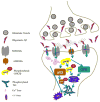Multiple faces of dynamin-related protein 1 and its role in Alzheimer's disease pathogenesis
- PMID: 26708942
- PMCID: PMC5343673
- DOI: 10.1016/j.bbadis.2015.12.018
Multiple faces of dynamin-related protein 1 and its role in Alzheimer's disease pathogenesis
Abstract
Mitochondria play a large role in neuronal function by constantly providing energy, particularly at synapses. Recent studies suggest that amyloid beta (Aβ) and phosphorylated tau interact with the mitochondrial fission protein, dynamin-related protein 1 (Drp1), causing excessive fragmentation of mitochondria and leading to abnormal mitochondrial dynamics and synaptic degeneration in Alzheimer's disease (AD) neurons. Recent research also revealed Aβ-induced and phosphorylated tau-induced changes in mitochondria, particularly affecting mitochondrial shape, size, distribution and axonal transport in AD neurons. These changes affect mitochondrial health and, in turn, could affect synaptic function and neuronal damage and ultimately leading to memory loss and cognitive impairment in patients with AD. This article highlights recent findings in the role of Drp1 in AD pathogenesis. This article also highlights Drp1 and its relationships to glycogen synthase kinase 3, cyclin-dependent kinase 5, p53, and microRNAs in AD pathogenesis.
Keywords: Alzheimer's disease; CDK5; Drp1; GSK3β; miRNA; mitochondria; p53.
Copyright © 2015 Elsevier B.V. All rights reserved.
Figures








References
-
- Yan J, Liu XH, Han MZ, Wang YM, Sun XL, Yu N, Li T, Su B, Chen ZY. Blockage of GSK3beta-mediated Drp1 phosphorylation provides neuroprotection in neuronal and mouse models of Alzheimer’s disease. Neurobiol Aging. 2015;36:211–227. - PubMed
-
- Reddy PH, Tripathi R, Troung Q, Tirumala K, Reddy TP, Anekonda V, Shirendeb UP, Calkins MJ, Reddy AP, Mao P, Manczak M. Abnormal mitochondrial dynamics and synaptic degeneration as early events in Alzheimer’s disease: implications to mitochondria-targeted antioxidant therapeutics. Biochim Biophys Acta. 2012;1822:639–649. - PMC - PubMed
-
- Binukumar BK, Gupta N, Sunkaria A, Kandimalla R, Wani WY, Sharma DR, Bal A, Gill KD. Protective efficacy of coenzyme Q10 against DDVP-induced cognitive impairments and neurodegeneration in rats. Neurotox Res. 2012;21:345–357. - PubMed
Publication types
MeSH terms
Substances
Grants and funding
LinkOut - more resources
Full Text Sources
Other Literature Sources
Medical
Research Materials
Miscellaneous

